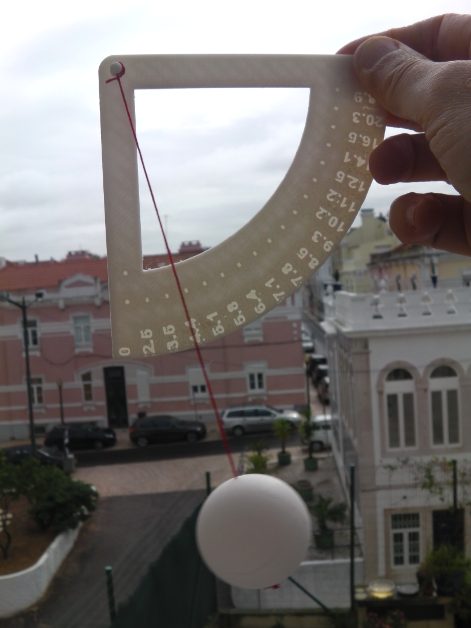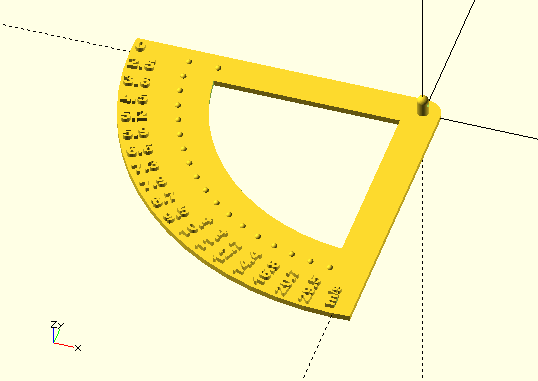Sphere anemometers are simple devices that use the wind drag force on a sphere to determine the wind speed by equating the weight of the sphere with the drag force in a pendulum like configuration.

The drag force is the force that a sphere feels when traveling with a certain
speed  in a viscous fluid (relatively to the fluid, in our case
air). This forces depends on the relative velocity between the air and the sphere,
on the density of the air
in a viscous fluid (relatively to the fluid, in our case
air). This forces depends on the relative velocity between the air and the sphere,
on the density of the air  , effective area in contact with the fluid
, effective area in contact with the fluid and an adimensional
coefficient
and an adimensional
coefficient  called the drag coefficient. In this case this force
amounts to
called the drag coefficient. In this case this force
amounts to

Note that the drag coefficient  is a geometric factor
and is usually determined experimentally. For a sphere, for high enough
Reynolds numbers, the drag
coefficient is around
is a geometric factor
and is usually determined experimentally. For a sphere, for high enough
Reynolds numbers, the drag
coefficient is around 0.5.
Apparently this kind of anemometer was invented in 1900 by G. Daloz. Modern versions includes a ping-pong ball.
Equating the weight of the sphere

with the drag force in a pendulum like configuration for a given equilibrium position one gets

and for the velocity:
 Where D=2 R is the diameter of the ping-pong ball.
Where D=2 R is the diameter of the ping-pong ball.
Given that a ping-pong ball has mass of 2.7g and a typical diameter of 40mm one gets for the density rhoball=2.7/(4*pi/3*2^3)~0.081 g/cm^3
and thus


Here's the OpenSCAD file:
// Author: Tiago Charters de Azevedo // Maintainer: Tiago Charters de Azevedo // Copyright (c) - 2016 Tiago Charters de Azevedo (tca@diale.org) // This program is free software; you can redistribute it and/or modify // it under the terms of the GNU General Public License as published by // the Free Software Foundation; either version 3, or (at your option) // any later version. // This program is distributed in the hope that it will be useful, // but WITHOUT ANY WARRANTY; without even the implied warranty of // MERCHANTABILITY or FITNESS FOR A PARTICULAR PURPOSE. See the // GNU General Public License for more details. // You should have received a copy of the GNU General Public License // along with this program; if not, write to the Free Software // Foundation, Inc., 51 Franklin Street, Fifth Floor, // Boston, MA 02110-1301, USA. // Gravity aceleration g=9.8; //(m/s^2) rhoair=0.001225; // (g/cm^3) // pi pi=3.1415926; /*Drag coeficiente .5 sphere see: https://en.wikipedia.org/wiki/Drag_coefficient */ Cd=.47; // Ping-Pong D=.04; // (m) mball=2.7; // (g) A=pi*pow(D/2,2); rhoball=mball/(4*pi/3*pow(100*D/2,3));// 0.081; // (g/cm^3) // Font size fsize=4; R=100; h=2; coef=1;//3.6*0.621371; module slice(h=2){ difference(){ cylinder(h,R,R,center=true,$fn=64); translate([0,2.5*R/2,0]){ cube([2.5*R,2.5*R,2*h],center=true);} translate([2.5*R/2,0,0]){ cube([2.5*R,2.5*R,2*h],center=true);}}} module vscale(){ for(alpha=[0:5:89]){ v=coef*sqrt(pi*g*rhoball*pow(D,3)*tan(alpha)/(3*A*Cd*rhoair)); rotate([0,0,alpha]){ translate([-R*.99,0,-0]){ rotate([0,0,-0]){ linear_extrude(height=h,scale=1,twist=0,convexity= 0){ text(str(floor(v*10)/10),size=fsize,font="Arial Black:style=Bold",center=true);}}} translate([-R*.8,-1*0,h/2]){ sphere(h/2,center=true,$fn=64);}}} translate([-R*.7,-1*0,h/2]){ sphere(h/2,center=true,$fn=64);} translate([0,-R+2,0]){ rotate([0,0,90]){ linear_extrude(height=h,scale=1,twist=0,convexity= 0){ text("m/s",size=fsize,font="Arial Black:style=Bold",center=true);}}}} //difference() { intersection(){ union(){ difference(){ slice(); cylinder(10,R*.7,R*.7,center=true,$fn=64);} translate([0,-R/2,0]){ cube([6*h,R,h],center=true);} translate([-R/2,0,0]){ cube([R,6*h,h],center=true);}} cylinder(10*h,R,R,center=true,$fn=64);} vscale();} cylinder(h,3*h,3*h,center=true,$fn=64); difference(){ union(){ cylinder(3*h,h,h,center=false,$fn=64); translate([0,0,3*h]){ sphere(h,center=true,$fn=64);}} translate([0,0,2.5*h]){ rotate([0,90,0]){ cylinder(3*h,1,1,center=true,$fn=64);}}}
Created: 08-05-2016 [18:12]
Last updated: 23-01-2025 [00:04]
For attribution, please cite this page as:
Charters, T., "Ping-Pong Anemometer": https://nexp.pt/Ping-Pong-Anemometer.html (23-01-2025 [00:04])
(cc-by-sa) Tiago Charters - tiagocharters@nexp.pt